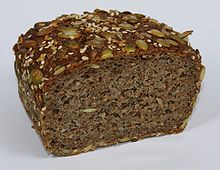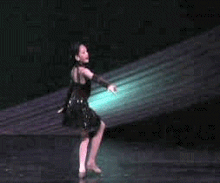Healthy eating habits/Effective Eating for Dancers: Eating for Energy, Concentration and Focus

The following page provides a simple guide in regards to nutrition and its role in boosting performance within the dance setting, in particular enhancing energy, concentration and focus. For further information about fuelling, hydration and recovery and how these parameters influence performance, visit the Ausdance factsheet page and the Australian institute of sport website.
Why is Eating Important for Dancers?
[edit | edit source]Dancing is physically vigorous and requires a great deal of focus and stamina. Constant rehearsal and performance takes a toll on muscles, joints and bones. In order for dancers to perform at their best, it is very important that they are well fuelled. A balance of nutrients will not only improve energy, concentration and focus, but also will also assist in injury and fatigue prevention and promote longevity within the dance industry.

Carbohydrates
[edit | edit source]Carbohydrates are the main source of energy for the muscles during training. After digestion, carbohydrates are broken down into glucose. Glucose is then taken up by our cells and stored as glycogen and converted to energy when it is needed. A dancers diet should typically be 55-60% carbohydrate. During intense training and rehearsal, carbohydrate should be increased to make up 65% of all calories consumed.
The best sources of carbohydrates for dancers are complex carbohydrates, such as wholegrain cereals, breads, rice, starchy vegetables, fruit and pasta.
Protein
[edit | edit source]Protein is required by dancers to build and repair muscle that has been stressed through continuous use. It is also a fuel source for the body and plays an important part in metabolism. Dancers should consume between 1.4-1.6 grams of protein per kilogram of body weight.
The best sources of protein for dancers come from lean meats and poultry, tofu, beans and dairy
Fat
[edit | edit source]Fat is a predominant fuel source during prolonged, continuous activity over 20 minutes, so it is crucial that fat is consumed. Dancers should aim to consume around 1.2 grams of fat per kilogram of body weight.
The best sources of fat come from monounsaturated and polyunsaturated sources including oils (olive, canola, sunflower), nuts (almonds, walnuts, macadamia, pecans), avocado, fatty fish (salmon, tuna, sardines) and olives.

Breakfast
[edit | edit source]I’m sure you have heard it numerous times, but yes, it is true, breakfast is the meal that kick starts your metabolism and provides you with energy for the day. Dancers should consume a breakfast adequate in calories that is rich in complex carbohydrates, moderate in protein and low in fat to prepare them for the activity that is to follow. Although you may not feel inclined to eat that early on in the morning, it is important that you at least eat something to fuel your mind and body.
More often that not, eating breakfast is a case of habit, that is we don’t feel like eating it because we don’t usually eat it; we have trained ourselves not to want or feel like it. This can be easily overcome by simply tempting our taste buds with a little bit of something. Even drinking a glass of water with squeezed lemon first thing in the morning will awaken the taste buds and get those digestive juices flowing.
Suitable breakfast options
[edit | edit source]- Scrambled eggs on wholegrain toast: good source of both carbohydrate and protein
- Greek yogurt and berries: Greek yogurt has almost twice the protein of regular yogurt; berries are a good source of antioxidants and vitamin C
- Banana and blueberry soy shake: convenient for on the go; also a good source of both carbohydrate and protein
- Wholegrain toast with sliced tomato, cheese and turkey: good source of both carbohydrate and protein
Not so suitable breakfast options
[edit | edit source]- Bacon, fried eggs, and hash browns on white toast: high fat breakfast, digests more slowly and often leaves us with a sick stomach feeling
- Pancakes with maple syrup, icing sugar and ice cream: lots of simple sugars here, which are broken down quickly by the body, causing an energy spike, followed by an energy crash shortly after.
- Store-bought blueberry muffin: quite convenient, but is sugar-rich and will also cause a rapid energy spike
Combining carbohydrate and protein
[edit | edit source]Carbohydrate is the body’s preferred fuel source. It is the most easily broken down for immediate energy. It is important for dancers to consume enough carbohydrate to keep them afloat. Consuming carbohydrate with a little bit of protein is beneficial, as it causes a more slow and sustained release of sugar into the bloodstream. It also prevents energy spikes and rapid energy crashes from occurring. As a result, you will feel fuller for longer and have a prolonged release of energy throughout class or during performance for improved focus and concentration.

Good carbohydrate-protein meals/snacks
[edit | edit source]- Tuna and beans on wholegrain crackers
- Fruit and nuts
- Yogurt and fruit
- Cheese on crackers
- Rice and chicken

Snacking
[edit | edit source]Extended class or rehearsals require dancers to refuel every 2-3 hours. Snacks that are most available for on the run however are usually not the best choice. Foods such as chips, lollies and chocolate do not provide dancers with the nutrients they need for building muscle, staying mentally focused and keeping energy levels sustained. When choosing snacks, think about consuming ‘meal type foods’ such as sandwiches, veggies with humus, leftovers, and tuna on crackers, but in smaller amounts. This will ensure you are getting a better array of nutrients. If you can, make sure you get some protein in, even if it’s a small amount, with every snack.
Useful resources
[edit | edit source]- Health and lifestyle video by the Australian Ballet School
- IADMS resource papers
- Australian Institute of Sport Factsheets
References
[edit | edit source]- Ausdance. (2014). Fuelling the dancer. Retrieved from http://ausdance.org.au/articles/details/fuelling-the-dancer
- Australian Institute of Sport. (2014). Basics. Retrieved from http://www.ausport.gov.au/ais/nutrition/factsheets/basics
- International Association for Dance Medicine & Science. (n.d.) Nutrition Factsheet Fueling the Dancer. Retrieved from http://c.ymcdn.com/sites/www.iadms.org/resource/resmgr/resource_papers/dance_nutrition.pdf
- Safety and Health in Arts Production and Entertainment. (2006). Good Nutrition for Dancers. Retrieved from http://www.actsafe.ca/wp-content/uploads/resources/pdf/dancernutrition.pdf